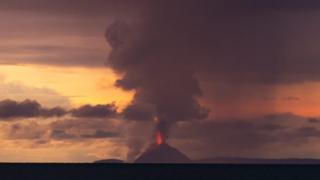 Image copyright
Image copyright
Oystein Lund Andersen
This image of Anak Krakatoa erupting was taken by Oystein Lund Andersen on Saturday
At least 43 people have been killed and 584 injured after a tsunami hit the coast on Indonesia’s Sunda Strait, government officials say.
The country’s disaster management agency says hundreds of buildings were damaged by Saturday’s tsunami.
It says the possible cause of the tsunami was undersea landslides after the Krakatoa volcano erupted.
The strait, between the islands of Java and Sumatra, connects the Java Sea to the Indian Ocean.
What is the latest?
The disaster management agency warned that the death toll after the tsunami, that struck at about 21:30 local time (14:30GMT) on Saturday, is likely to rise further.
Deaths have been reported in the Pandeglang, South Lampung and Serang regions. Among the areas hit was the popular Tanjung Lesung beach resort in west Java.
Image copyright
BNPB
Images released by Indonesia’s disaster management agency showed devastation in Anyer
Image copyright
AFP/Getty Images
Many houses were flattened by the devastating waves
Footage shared on social media showed a large wave crashing into a venue in the resort, where a popular band, Seventeen, was performing.
Indonesian media report that at least two band members are missing.
The country’s Red Cross said it was on the scene and searching for victims in the rubble of one collapsed building.
‘There were two waves’
Oystein Lund Andersen, Norwegian volcano photographer, Anyer Beach in West Java
I was on the beach. I was alone, my family were sleeping in a room.
I was trying to photograph the erupting Krakatoa volcano.
Earlier in the evening, there was quite heavy eruption activity. But just prior to the waves hitting the beach, there was no activity at all. It was just dark out there.
And suddenly I saw this wave coming, and I had to run.
There were two waves. The first wave wasn’t that strong – I could run from it.
Image copyright
Oystein Lund Andersen
Flooded streets in Anyer after the tsunami
I ran straight to the hotel, where my wife and my son were sleeping.
And I woke them up… and I heard a bigger wave coming. I looked out of the window when the second wave hit. It was much bigger.
The wave passed the hotel. Cars were pushed off the road.
We and other people at the hotel went straight to the forest (on higher ground) next to the hotel. And we’re still up on the hill now.
– Oystein Lund Andersen was speaking to BBC World News television
What might have caused the tsunami?
Emergency officials are investigating whether the tsunami was caused by Anak Krakatoa, a volcanic island in the Sunda Strait.
Volcanologist Jess Phoenix told the BBC that when volcanoes erupt, hot magma pushes underground and can displace and break through colder rock. This can trigger a landslide.
But because part of Krakatoa is underwater, she said “instead of just causing a landslide, you get an undersea landslide which pushes water as it moves.” This can then cause a tsunami.
The Anak Krakatoa volcano has seen increased activity in recent months.
Indonesia’s geologic agency said that the volcano erupted for two minutes and 12 seconds on Friday, creating an ash cloud that rose 400 metres (1,300ft) above the mountain.
It recommended that no-one be allowed within two kilometres of the crater.
Image copyright
Gallo Images/Orbital Horizon/Copernicus Sentin
A satellite image of Anak Krakatoa erupting in August
The disaster management agency said that high seas as a result of the full moon may also have contributed to the strength of the waves.
Is this unusual?
Image copyright
Reuters
Some residents in the Pandeglang region ran to a local mosque after the tsunami hit
Indonesia is prone to tsunamis because it lies on the Ring of Fire – the line of frequent earthquakes and volcanic eruptions that circles virtually the entire Pacific rim.
In September, more than 2,000 people died when a powerful earthquake struck just off the central Indonesian island of Sulawesi, setting off a tsunami that engulfed the coastal city of Palu.
On 26 December 2004, a series of huge waves triggered by a powerful earthquake in the Indian Ocean killed about 228,000 people in 14 countries, mostly in Indonesia.
However, tsunamis caused by volcanic activity like this are less frequent.
Krakatoa (Krakatau in Indonesian)
Image copyright
Oystein Lund Andersen
In August 1883, it underwent arguably the most violent volcanic eruptions in recorded history:
- Massive tsunamis with waves up to 135ft (41m) killed more than 30,000 people
- Thousands more were killed by hot ash
- The eruptions were equivalent to 200 megatons of TNT – about 13,000 times the nuclear yield of the bomb dropped on Hiroshima in 1945
- The eruptions were heard thousands of kilometres away
- World temperatures dropped by more than 1C the following year
- The volcanic island virtually disappeared
In 1927, a new island, Anak Krakatoa (Child of Krakatoa) emerged



